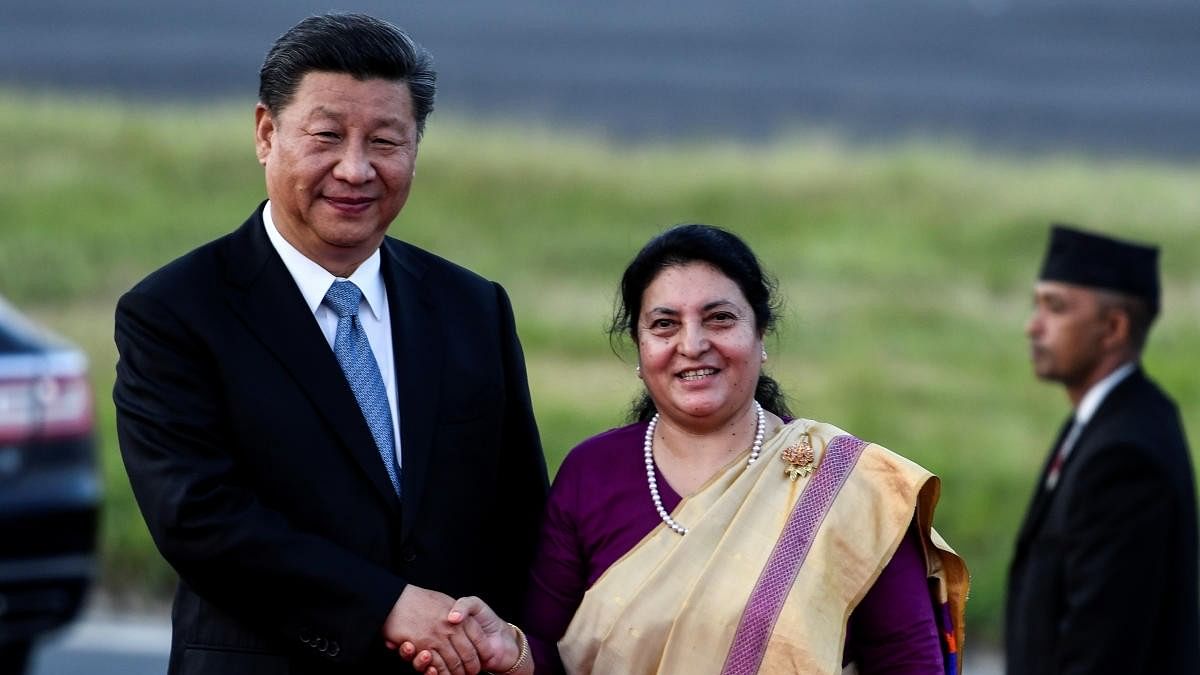
Nepal's President Bidhya Devi Bhandari shakes hands with China's President Xi Jinping during a welcome ceremony at Tribhuvan International Airport in Kathmandu, Nepal October 12, 2019.
Credit: Reuters Photo
The intense jostling for influence among the Great Powers in strategically located Nepal has once again gained momentum. While China was busy reiterating the benefits of its Belt and Road Initiative (BRI) to visiting Nepalese PM Pushpa Kamal Dahal ‘Prachanda’ late last month, the US promptly dispatched Alice Albright, the head of its Millennium Challenge Corporation (MCC), a counter to the BRI, to the Himalayan nation within days of his return from Beijing.
For a country that adheres to a policy of non-alignment, Nepal increasingly finds itself in the midst of a geo-strategic contest. With its own high strategic stakes in Nepal, India is undoubtedly closely monitoring developments there. Having traditionally held sway over a country with whom it shares a long and porous border, India has seen a significant reduction of its strategic space in Nepal, with China making rapid inroads.
In this complex scenario, Kathmandu must deftly balance its own strategic and developmental imperatives as well as its ties with the big three—New Delhi, Beijing, and Washington. During Prachanda’s visit to China, the two sides signed 12 MoUs, but the trip did not yield significant outcomes for either side. Nevertheless, India knows well that Beijing’s growing presence in the Himalayan nation poses a clear and present threat.
To New Delhi’s relief, its relations with Kathmandu in the 10 months since the Maoist leader took over as PM have remained stable. However, it understands the need to stay vigilant, as the tide can turn against it at any time. Fickleness and opportunism are the hallmarks of Nepal’s politics and politicians, adept at playing Beijing against New Delhi. This has complicated India’s position in a country it once considered its strategic backyard.
In an effort to counter Chinese influence in Nepal, Washington has also sought a firmer foothold there. The alignment of India and the US regarding China’s growing belligerence in the region and the broader Indo-Pacific should aid their common cause to check Beijing’s expansionist moves in Nepal. Washington has reason to be pleased, having got Nepal on board the $500 million MCC Compact after strenuous efforts.
In sharp contrast, Nepal and China have been unable to finalise the text for the BRI Implementation Plan even six years after the former joined the initiative. Prachanda’s visit saw the two sides resolve to accelerate discussions on it. Not a single project under BRI has taken off in Nepal since 2017. Under pressure from both the US and India, the realisation that BRI projects often lead to significant debt traps may also be weighing heavily on Kathmandu’s mind.
New Delhi would also be wary of Beijing’s latest initiatives: the Global Security Initiative (GSI), the Global Civilisation Initiative (GCI), and the Global Development Initiative (GDI). Mindful perhaps of Indian security interests, Kathmandu has not joined either the GSI, seen as an attempt by Beijing to forge its own security architecture, or the GCI. However, Beijing managed to nudge Nepal into backing the GDI with a joint statement, stating that Nepal supports it and “will consider” joining it. But this can only be seen as a face-saver at best for Beijing, as Kathmandu has not made a commitment to join it.
Both India and China are also seeking to push ahead with energy cooperation and connectivity projects with the landlocked nation. Nepal, having suffered during the unofficial economic blockade imposed by India in 2015, is keen to explore connectivity projects with China that would reduce its dependence on India. A feasibility study is on for the proposed Jilong/Keyrung-Kathmandu cross-border railway network, despite its seeming impossibility. A beginning has also been made enabling Nepal to receive transhipments from a third country using Chinese ports—it got turmeric from Vietnam via the Tianjin port last month.
Redoubling its efforts to keep Nepal within its orbit, India has agreed to import 10,000 MW of power from Nepal in the next decade, even as it invests in the country’s hydropower sector. But the 6,480 MW Pancheshwar hydropower project remains in limbo over a quarter of a century after it was first mooted with the preparation of its feasibility report, headed nowhere.
The fragile coalition Prachanda leads is perhaps one reason for him to be more amenable to New Delhi’s overtures. With his party, the CPN (Maoist Centre), winning merely 32 seats in the 275-member Parliament, Prachandas’s government is dependent on the support of the pro-India Nepali Congress, which got 89 seats, for survival. Perhaps it explains why New Delhi-Kathmandu relations have not encountered stormy weather yet. But India can ill-afford to lose steam in Nepal.
(The writer is a senior Delhi-based journalist)